First things first: a shout-out to Kimric at Smythe’s Accordion Center in Oakland, CA http://www.smythesaccordioncenter.com/ Kimric helped me think through the process, and gave me access to tools and space at Smythe’s Accordion Center.
Below is a detailed description of my accordion’s tuning system and the steps it took to convert my bass system from a standard diatonic bass system to a bi-directional 12-note system. I focused mostly on changes made to the reed block; because there are already resources out there which will explain how to wax in reeds. This blog is the only public resource for changing your bass system that I know of.
WARNING: the following information may bore and/or confuse you unless you’ve already messed around with diatonic accordions. If you’re a diatonic player, and you’ve been playing with limited chord options for years, this description might be very intriguing. Maybe you’ll want to expand your accordion’s harmonic vocabulary too! This blog post will describe some of the steps for converting a 100-year-old Hohner button accordion with 12 bass buttons into a modern accordion which can play in all keys.
The old Hohner I’m restoring was originally in G/C tuning. I play a D/Eb tuning, so I took out all the old reeds and replaced them.
One nice thing about the D/Eb Irish system tuning is that I’ll be able to play in all keys on the right hand. (Irish system tunings consist of two major scales a half step apart, so you can play all the notes of the chromatic scale, but roughly half the notes are available only on the push and the other half only on the pull. Playing in keys other than D and Eb involves cross-row fingerings which are hard to memorize at first. Also, you push in and pull out the bellows constantly while you’re playing; I think that’s sexy. Go ahead, call me a pervert, I agree with you! In-out-in-out…)
In the photo above, you can see how the original chord block lines up with those holes in the deck. When a button is pressed, three holes will open, as in the photo below:
To add a left-hand bass system which also plays in all keys, I’ve had to replace the chord reedblock with a bass-note reedblock culled from a different accordion. See how the square holes are lined up in pairs?
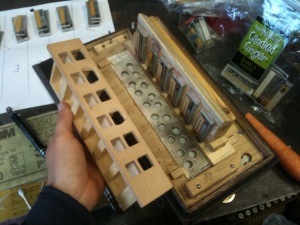
Those hole pairs correspond to the bass note octave-pairs. A low-0ctave G will face across from a high-octave g. It’s a great shape for the reeds, but it clearly doesn’t match up to this deck. I’ll have to widen these holes. That way, the reed chambers will receive more of the air from those little triads of holes on the deck once the block gets clamped in place.
The holes at the bottom of the reed block have been widened, and little holes cut at the bases of the chambers to connect the air supplies of the bass note pairs. The higher octave reed is likely to respond faster when played because it has less mass; the sympathic vibration that the high reed causes in the low reed will make the low reed respond faster. This effect is amplified when you open the little chamber up between the two reeds. Hopefully, the result will be bitchin-fast bass response!
If you look closely, you can see another row of deck holes peeking through the holes in the reed block. That was not something you’d have seen from this angle before I put holes in the reed chambers. I now have a reedblock shaped so that the air from those three deck holes will play two reeds.
This octave-note pairing in the bass reeds gives me a full bass sound which doesn’t overpower the melody when I do a lot of left-hand drone accompaniment and power chords. Rock! Unfortunately, this means that I’ll have a few extra steps to take in cutting down and shimming one half of this reed block to accomodate shorter, smaller reeds.
First, I took down the top of the reedblock with a saw.
Then, I shaped it on the belt sander at Amazing Grace.
Next, I adjusted the reed chambers for a smaller width reed set using wooden shims. The reeds have to rest at a very precise edge of the wood… if the gap is too narrow, the inside valve will choke against the wall; if the gap is too wide, the reed will just fall into the chamber, and the wax won’t help you at all. Shims and glue are the only things for this job.
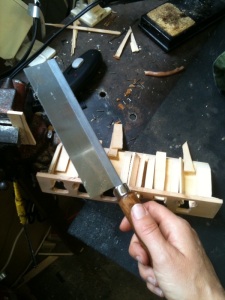 Cutting out shims to narrow the reed chambers.
Cutting out shims to narrow the reed chambers.
At this stage, I checked out the clearance that the two reedblocks had between each other once they were tightened down to the deck.
The clearance between the reed blocks is disturbingly small; maybe the valves or reeds could interfere with each other and cause bad notes. The reeds on that unfinished block will be raised about 3 mm further out than you can see in this image. Fortunately, it’s possible to install these shims off to one side and offset the reeds so flapping valves or long vibrating reeds are not facing directly across from each other. I don’t have to mess with the reedblock spacing on the deck, since the problem will be negated by putting two shims on the right sides of all the little chambers. Yay!
I have no photos showing you the process of supergluing the shims in place; I didn’t want to get superglue on my phone. I love superglue. It makes the job faster with only moderate risk of gluing yourself to the project! 😉
Chiseling the shims flush with the surface of the reed block after they’ve been glued in and sawed down.
Note: this is a retarded angle for chiseling the piece, I was just posing for the photo. Always point the chisel away from yourself! Keep your hand and arm out of the path of travel! And your leg too!
Next, I superglue a piece of walnut to be top for all the reed chambers.
Ha! You can totally see spots where I glued some of my fingertip skin to the piece. 😀 Next, I get to lay those higher-octave bass reeds down and check the fit.
The reeds fit with few adjustments. I’m going to spooge a bunch of wax at the bass and top of the reeds, to temporarily hold them down while I check out the sound of all the reeds. I still have to check for octave balance at this point; I might well end up changing out some of these reeds if the resulting bass notes sound too high, low, strong or weak compared to the rest of the instrument.
Here, at last, I show you the bass note arrangement that I’m installing:
F G A B C# Eb
Bb C D E F# Ab
This arrangement has all 12 tones in the Western tempered scale, set in a pattern where the power-chord tones are lying next to each other. C is next to G (C power chord) and diagonal to F (F power chord) G is diagonal to D (G power chord). The fingerings are very easy in keys with sharps. It’s a little more awkward in keys with flats because that Eb is about as far away from Bb as you can get. I can add the thirds to my chords if I want to; but I tend to be sparing with those unless I’m walking the bass line through them.
Traditional diatonic accordion bass sides are so limiting. On a Cajun melodion, you only get two chords, and each chord only plays in one direction! On this old Hohner, there were probably about 10 or 12 individual chords available, set up very well for an accompaniment style that goes OOM PA PA, limited to a very few keys. My new system gives you more control over what harmony you’re playing, regardless of which direction the bellows are going at any moment; and it lets you play bass in all the keys and modes. Each button plays the same note in both directions, but no single button will give you a chord; you have to find the combination which gives you the harmony or bass line you’re looking for.
Modern pop music is defined not just by melody, but by bass line and groove as well. One motivation I have for building this system is to enable the instrument to play bass lines more like they’re played by actual bass players. So, I’ll have much more flexibility when I’m playing solo; I can come up with song arrangements that have better fidelity to the original versions; or write my own songs with more developed bass lines. It’s still a neat advantage when I play with a band; I can kick in a huge boost in the feel of the song when I start a 16th-note power chord drone under the groove. Suddenly a little accordion is playing a Ramones power-punk feel, with dramatic in-outs and a whole lot of shaking.
I can feel some piano accordion player smirking as she reads this… yeah, I know, you get all the notes in both directions on keyboard accordions. I’m creating a special hybrid button box which can still only play only a fraction of the note combinations that a piano or chromatic accordion can play. What can I say? I’m in love with a strange little instrument. It’s small, makes an extremely efficient use of materials, needing only half as many reeds and buttons and key-arms as a full-size piano accordion, while being able to perform an equally wide melody range. It’s light enough for me to be able to move the bellows very quickly, and even dance while wearing it. I’ll still be able to pick it up when I’m 85, and it fits under an airplane seat; yet it can play the same range and volume as an instrument twice its size. It’s hard to learn, and this conversion job has taken a long time; but playing it is so very fun!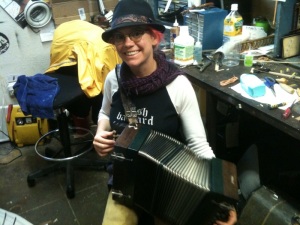

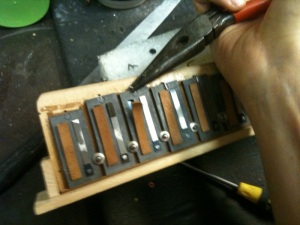
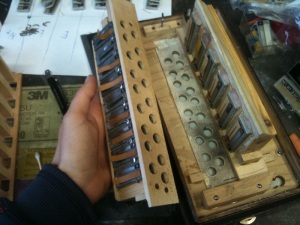
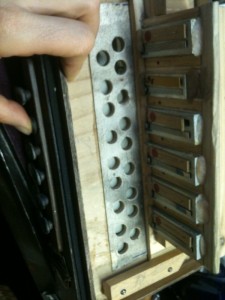
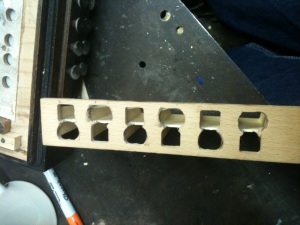
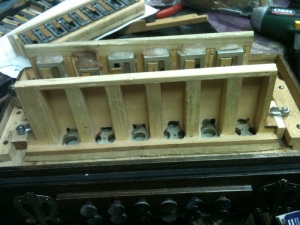
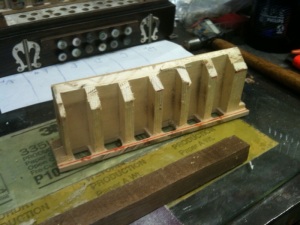
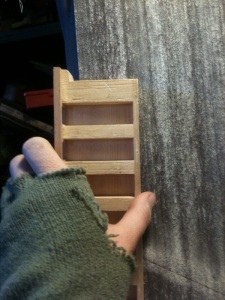
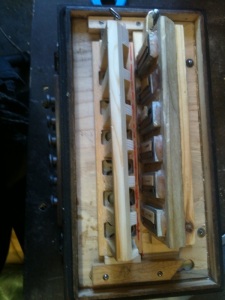
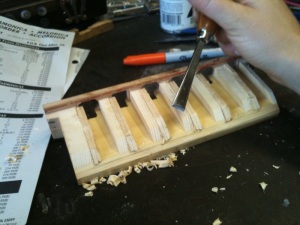

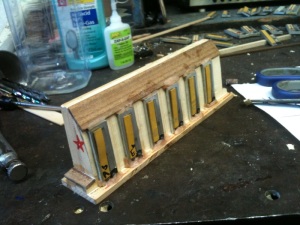
Update: I changed the reed order since then… I moved Eb and Ab over to the bottom of the column.
F# E D C Bb Ab
C# B A G F Eb
It’s essentially impossible to play the C# power chord, I want to get an accordion with a few more bass buttons so I can have the C#/F# at the top and the bottom.
hei. do you have some sound test link in web? and if i need help or i have questions for this, can i get some help for you?
I never recorded this instrument and it’s at a friend’s house 10,000 miles away from me at the moment. Next time I go to California I’ll make a recording to go with this blog post. I have a newer accordion (Weltmeister) which also features the 12-tone bass system. I like the idea of putting a video out with clips of songs in many keys to show what such an accordion can do!
http://squeezeboxgoddess.com is not loading. Anyways I am doing the same thing with a liliput but I am rowing the notes up in a descending chromatic scale. And making the treble side also chromatic so I can play in my F F# B A# keys. You should cover some of my songs. I am the best song writer in the states. http://www.youtube.com/user/wonderlandrockopera I must have 100 songs now. Cock, Plow and Hole, Soon comes time, and Hoe are some of my best writing. I also wrote a 19 song rock musical called WonderlandRockOpera.com but I got to get the web page up again. I am busy pimping a liliput and that is how I found you. Hi ……Egg Man at your service.